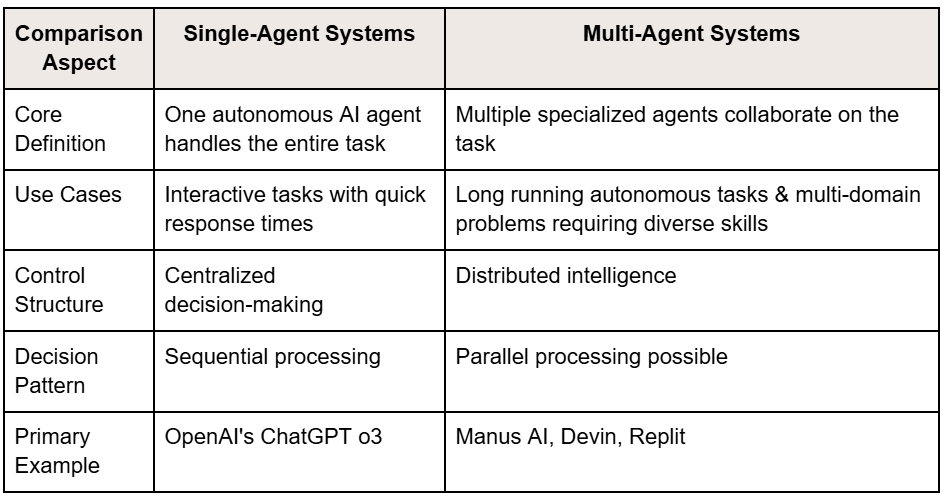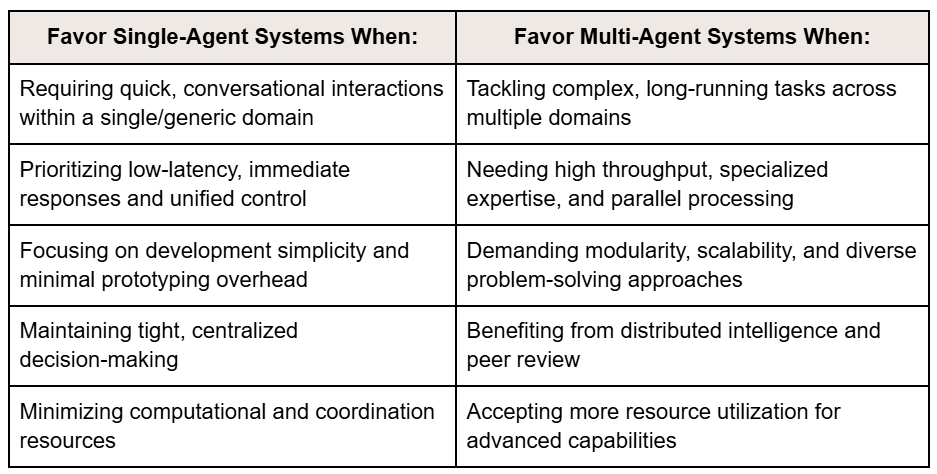Single-Agent vs. Multi-Agent

Mohamed Elseidy
·May 5

Single vs multi agent diagram
Introduction
Soon after the recent release of Manus AI and my article about it, we've witnessed a Cambrian explosion of AI Agents. The agent ecosystem has expanded rapidly with numerous frameworks designed specifically for building autonomous agents. Examples include Google's Agent SDK and the A2A protocol, OpenAI Agents SDK. We have also seen new models come out like o3, which resolves multimodal prompts with impressive speed, accuracy, and a wide breadth of capabilities, clearly distinguishing itself from previous models.
At first glance, people confused ChatGPT o3 (the App, not the API) with just a reasoning model that prompts an LLM directly. But in fact, o3 is an agentic framework that operates by using and combining every tool within ChatGPT, from web browsing to code execution and image recognition, etc.
What makes o3 interactive and fast is that it follows a single-agent architecture. Single-agent systems employ a single AI model equipped with tools and instructions to execute workflows in loops. This is usually sufficient for the common use cases which are conversational and user-interactive. Multi-agent systems, conversely, distribute the workload among several specialized agents working together. This approach is suitable for complex, parallelizable tasks demanding varied expertise with limited human involvement.
In this essay, we will explore the differences between these two architectures, their use cases, and which design to choose when building agents using the SDKs. The TLDR can be summarized in the following table:

Single-Agent Systems
A single-agent system (SAS) uses a single orchestrator to handle all aspects of a task, serving as the center of decision making. This agent may use various tools & functions (APIs, code execution, data retrieval), but these are invoked by the agent itself rather than independent AI peers.
Modern single-agent systems like ChatGPT’s o3 exemplify this approach. o3 agentically uses and combines every tool within ChatGPT, including web browsing, code execution, visual processing, and image generation. It internally decides when and how to use these tools, effectively operating as an all-in-one AI assistant with a unified reasoning process.
This idea isn't new; AutoGPT was among the first single agents pushed forward back in 2023. AutoGPT largely follows a monolithic paradigm, with one GPT-based agent that iteratively generates plans, executes tasks, evaluates results, and updates its plan until the goal is achieved.
What makes o3 shine here is the power of its tools, the intelligence of the orchestrator, and the speed at which results come back interactively.
Strengths
The single-agent design offers various strengths, some of which are:
- Simplicity & Efficiency: Straightforward to design, deploy, and maintain, i.e., faster execution for straightforward tasks with no messaging delays
- Unified Context: No need for complex communication protocols, i.e., all context resides in one agent that maintains one coherent perspective throughout the session
- Operational Benefits: Often cheaper than multiple specialized models, i.e., easier to debug with only one reasoning chain
OpenAI found that the suitability of the single agent design aligns well with their current product (ChatGPT) requirements:
- Good enough for the vast majority of end-user tasks that require interactivity & memory
- Cheaper, faster, and easier to guard than coordinating a swarm of agents
- Forward-compatibility: they can always extend this design to multi-agents
Multi-Agent Systems
Multi-agent systems (MAS) emerged to address long-running or complex tasks where single-agent approaches fall short. For autonomous workflows that span hours or days, or require operating across multiple domains, single agents fall back due to several limitations:
- Capability Constraints: Tasks may exceed what one agent can effectively handle + limited context window constraints
- Processing Limitations: one agent must be competent across all required domains + Inability to efficiently parallelize subtasks for efficiency
- Reliability Concerns: self-review may miss critical issues that peers would catch + no redundancy if the agent makes mistakes
To overcome these limitations, multi-agent architectures distribute work across a team of specialized AI agents. In these systems, agents must communicate and coordinate their actions. Architectural patterns vary from a hierarchical style (coordinator/delegators) to more decentralized (peer-to-peer) styles. A key aspect is establishing protocols for interaction, like Google's latest A2A protocol, which standardizes how AI agents can communicate and collaborate regardless of their underlying implementations.
Manus AI exemplifies this approach in the commercial space, using specialized agents for different business functions that collaborate within a multiagent framework. We previously wrote about Manus AI here. Another notable example is Devin, an "AI software engineer" that uses a multi-agent architecture with specialized components for different aspects of the software development process. Devin employs separate agents for planning, coding, testing, and debugging that work together in a coordinated fashion to complete programming tasks.
Strengths
Multi-agent systems offer a powerful approach to complex problem-solving through distributed, specialized intelligence:
- Adaptive Collaboration: Agents can specialize, work in parallel, and dynamically check each other's work, creating a fault-tolerant system that can tackle complex tasks more efficiently than a single generalist agent
- Flexible Architecture: The modular nature allows seamless addition of new agents and enables emergent problem-solving approaches, where creative solutions can arise from nuanced interactions between specialized components
Manus chose a multi-agent framework because of its product promise of autonomously finishing complex, long, multi-modal tasks. These tasks demand parallelism, specialization, resilience, and flexible model selection. In these cases the goals sought after outweigh the extra orchestration complexity that single-agent systems like ChatGPT would avoid.
Unfortunately, there is no such thing as free lunch. Despite their potential, multi-agent systems introduce operational challenges, e.g., coordinating multiple agents creates overhead and requires continuous resource management and goal alignment. Moreover, it requires more computational requirements, intricate debugging processes, and sound communication protocols to ensure performance.
These challenges underscore why multi-agent systems are typically reserved for scenarios where their advanced capabilities can justify the additional implementation complexity.
To SAS or MAS?
As agent development SDKs and frameworks like Google's Agent SDK, OpenAI Agent SDK, and LangChain proliferate, developers need to know which design path to take, either a single-agent or multi-agent approach. This choice hinges on balancing task complexity, resource constraints, and objectives. While single-agent architectures excel in simplicity and efficiency, multi-agent approaches unlock powerful capabilities for specialized and complex tasks.
The following table outlines the key scenarios that favor each approach:

agent comparison diagram
As a rule of thumb, single-agent approaches suffice for approximately 80% of common use cases. Many projects start with single-agent prototypes due to simplicity, only considering multi-agent architectures when dealing with long-running tasks, diverse domains requiring specialized expertise, or when requirements for scalability and fault tolerance become critical. The flexibility of multi-agent systems makes them particularly valuable for evolving requirements, as individual agents can be updated or replaced independently without disrupting the entire system.
Conclusion
The single-agent vs. multi-agent system decision represents a design choice between simplicity and specialization. Single agents excel at interactive tasks requiring quick responses and unified reasoning, while multi-agent systems shine when tasks demand diverse expertise, parallelism, and long-term execution.
For most user-facing applications requiring quick, interactive responses, a single powerful agent like ChatGPT’s o3 provides the optimal balance of capability and simplicity. However, as tasks become more complex, long-running, or require specialized domain knowledge across multiple fields, multi-agent architectures become increasingly valuable.
If you are designing a new agent, using the agent SDKs, the practical path forward is to start simple, with a single agent, and expand to multi-agent approaches only when justified by specific requirements. Also, let us know what you are building and apply to our accelerator Alliance.
More to Read
You're Vibe Coding Wrong

Mohamed Elseidy
·Jul 10
Most developers use Tier 1 for UX & rapid prototyping, Tier 2 for daily development, and Tier 3 for complex engineering challenges. The best strategy is to combine them when needed rather than trying to force one tool to do everything. Here's what each tier actually delivers and when you should use them
Your Moat Isn't Your AI Prompt. It's Your Evaluations

Mohamed Elseidy
·Jun 17
Anyone can copy a prompt, but they can't replicate the months of iterative learning, the domain knowledge and the edge cases discovered through real user interactions, and the systematic evaluation framework that guided every prompt tweaking decision.
Shopping is Dead, AI is Taking Over

Mohamed Elseidy
·May 28
Major payment networks are building the infrastructure while AI platforms began to deploy; for startups, this opens opportunities in vertical specialization and merchant tools; and SEO will evolve into AEO as businesses adapt to optimize for AI agents rather than human shoppers.